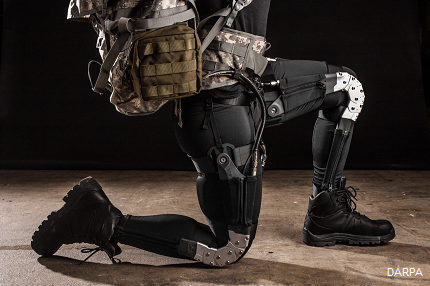Iron Man suit won't fly, but it could run a four-minute mile
DARPA’s Warrior Web project, primarily intended to reduce stress and injury, is also finding ways to boost performance.

Forget Iron Man. How about Roger Bannister?
The military has been working on several exoskeletal suits that could help soldiers carry their 100-pound loads more easily while reducing the all-to common risk of musculoskeletal injuries and making use of a variety of sensors. They’re sometimes referred to as “Iron Man suits” to give people a quick point of reference, even though nobody will use them to fly around the world with rocket boots that magically don’t seem to require a tank of fuel. But they might be able to run a four-minute mile.
The Defense Advanced Research Projects Agency’s Warrior Web program has been developing a lightweight undersuit since 2011, primarily to reduce the risk of injury by making a soldier’s load feel lighter. But in the course of developing devices to assist muscle movement, researchers are considering the possibility that the suit could increase speed, according to an Army report.
"We're assessing new technologies that could even allow a soldier to run a four-minute mile," said Lt. Col. Joe Hitt, who until recently was Warrior Web program manager. "For example, we have components such as motors and springs integrated into a suit which will augment the work performed by the muscles in the legs. This may be a pathway to enhancing performance."
"The theory behind it is if you can provide enough force to the runner, you could probably have them do a four-minute mile," said Michael LaFiandra, chief of the Dismounted Warrior Branch at the U.S. Army Research Laboratory, which with DARPA has tested nine Warrior Web prototypes during the first program’s first phase. "We're skeptical because we're researchers and it's part of our job to question everything. But, they're bringing the technology here. They want to demonstrate this four-minute mile concept and we're hopeful that they can do it."
That kind of performance boost would be a bonus to the program’s main goals, which are to reduce physical stress, monitor health signs and provide a way for soldiers in the field to be networked.
"The number one reason for discharge from the military in recent years is musculoskeletal injury," Hitt said. "Warrior Web is specifically being designed to address the key injuries at the ankle, knee, hip, lower back and shoulders." The idea is to make their load feel about half as heavy, in the process increasing their physical capabilities, he said.

In tests, soldiers have worn the prototype suits while walking a treadmill at the Soldier Performance and Equipment Advanced Research Facility at Aberdeen Proving Ground, Md., while researchers gather data on factors such as how hard their muscles are working and the amount of weight in footfalls. Soldiers also have worn the suits outside in rough terrain. Sensors can measure heartbeat, respiration and other health factors.
Warrior Web is one of several exoskeleton projects in government. DARPA has shared its finding with the TALOS (Tactical Assault Light Operator Suit) project being developed by an alliance of universities, research centers and national laboratories under the flag of the Special Operations Command, though DARPA is not part of that project.
NASA also is developing its X1 exoskeleton suit, which could have uses ranging from an in-space exercise device on long trips to helping people recover from debilitating injuries.
DARPA expects Warrior Web to be ready for its final test around the end of 2016, when a squad wearing the suits will take part in exercises such as a 12-mile march, marksmanship and completing an obstacle course, Hitt said. "Our vision is to significantly reduce the time it takes to do a rucksack march and then when you get onto the marksmanship course, you're almost as fresh as if you hadn't marched at all."
And since this month marks the 60th anniversary of Roger Bannister’s breakthrough, maybe they’ll also run the four-minute mile.